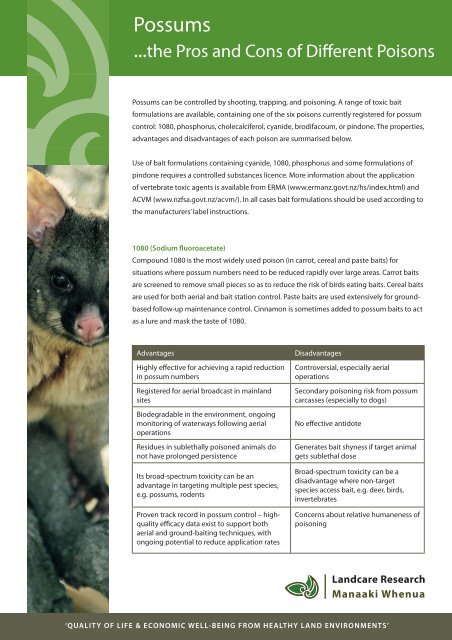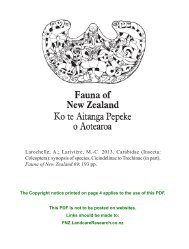Pros and cons of different poisons - Landcare Research
Pros and cons of different poisons - Landcare Research
Pros and cons of different poisons - Landcare Research
Create successful ePaper yourself
Turn your PDF publications into a flip-book with our unique Google optimized e-Paper software.
Possums<br />
...the <strong>Pros</strong> <strong>and</strong> Cons <strong>of</strong> Diff erent Poisons<br />
Possums can be controlled by shooting, trapping, <strong>and</strong> poisoning. A range <strong>of</strong> toxic bait<br />
formulations are available, containing one <strong>of</strong> the six <strong>poisons</strong> currently registered for possum<br />
control: 1080, phosphorus, cholecalciferol, cyanide, brodifacoum, or pindone. The properties,<br />
advantages <strong>and</strong> disadvantages <strong>of</strong> each poison are summarised below.<br />
Use <strong>of</strong> bait formulations containing cyanide, 1080, phosphorus <strong>and</strong> some formulations <strong>of</strong><br />
pindone requires a controlled substances licence. More information about the application<br />
<strong>of</strong> vertebrate toxic agents is available from ERMA (www.ermanz.govt.nz/hs/index.html) <strong>and</strong><br />
ACVM (www.nzfsa.govt.nz/acvm/). In all cases bait formulations should be used according to<br />
the manufacturers’ label instructions.<br />
1080 (Sodium fl uoroacetate)<br />
Compound 1080 is the most widely used poison (in carrot, cereal <strong>and</strong> paste baits) for<br />
situations where possum numbers need to be reduced rapidly over large areas. Carrot baits<br />
are screened to remove small pieces so as to reduce the risk <strong>of</strong> birds eating baits. Cereal baits<br />
are used for both aerial <strong>and</strong> bait station control. Paste baits are used extensively for groundbased<br />
follow-up maintenance control. Cinnamon is sometimes added to possum baits to act<br />
as a lure <strong>and</strong> mask the taste <strong>of</strong> 1080.<br />
Advantages Disadvantages<br />
Highly eff ective for achieving a rapid reduction<br />
in possum numbers<br />
Registered for aerial broadcast in mainl<strong>and</strong><br />
sites<br />
Biodegradable in the environment, ongoing<br />
monitoring <strong>of</strong> waterways following aerial<br />
operations<br />
Residues in sublethally poisoned animals do<br />
not have prolonged persistence<br />
Its broad-spectrum toxicity can be an<br />
advantage in targeting multiple pest species,<br />
e.g. possums, rodents<br />
Proven track record in possum control – highquality<br />
effi cacy data exist to support both<br />
aerial <strong>and</strong> ground-baiting techniques, with<br />
ongoing potential to reduce application rates<br />
Controversial, especially aerial<br />
operations<br />
Secondary poisoning risk from possum<br />
carcasses (especially to dogs)<br />
No eff ective antidote<br />
Generates bait shyness if target animal<br />
gets sublethal dose<br />
Broad-spectrum toxicity can be a<br />
disadvantage where non-target<br />
species access bait, e.g. deer, birds,<br />
invertebrates<br />
Concerns about relative humaneness <strong>of</strong><br />
poisoning<br />
‘QUALITY OF LIFE & ECONOMIC WELL-BEING FROM HEALTHY LAND ENVIRONMENTS’
Phosphorus<br />
Phosphorus is used as a paste <strong>and</strong> is generally applied to turf spits on the ground.<br />
Advantages Disadvantages<br />
Eff ective (kills <strong>of</strong> >90% achieved) Risks to operators <strong>and</strong> risk <strong>of</strong> fi re<br />
Cholecalciferol<br />
All registered bait formulations (pellets, paste <strong>and</strong> gel formulations) contain 0.8% cholecalciferol<br />
(vitamin D3) for fi eld application in bait stations for possum control <strong>and</strong> do not require a licence to use.<br />
Advantages Disadvantages<br />
Low risk <strong>of</strong> secondary poisoning to dogs <strong>and</strong><br />
birds<br />
Lower toxicity to birds than mammals reduces<br />
primary poisoning risk to birds<br />
Residues in sublethally poisoned animals do not<br />
have prolonged persistence<br />
Antidotes <strong>of</strong> limited value<br />
Broad-spectrum toxicity can be a disadvantage<br />
where non-target mammals or birds access bait<br />
Persistence in sublethally poisoned animals<br />
unknown<br />
Fate <strong>and</strong> persistence in the environment not<br />
well understood<br />
Concerns about relative humaneness <strong>of</strong><br />
poisoning<br />
Treatment for accidental poisoning is<br />
available, but is complex<br />
Fate <strong>and</strong> persistence in the environment not<br />
well understood<br />
Concerns about relative humaneness <strong>of</strong><br />
poisoning<br />
‘QUALITY OF LIFE & ECONOMIC WELL-BEING FROM HEALTHY LAND ENVIRONMENTS’
Cyanide<br />
Cyanide has been used by pest management agencies throughout New Zeal<strong>and</strong> for several decades<br />
for ground-based possum control, <strong>and</strong> is available to licensed users in paste <strong>and</strong> pellet formulations<br />
containing 475–600 g/kg cyanide. Cyanide paste baits are applied at times <strong>and</strong> in locations where<br />
exposure to rain or moisture is minimised. Pastes are generally applied with lures in various types <strong>of</strong><br />
weatherpro<strong>of</strong> bait station above ground level but may also be applied as an ‘unprotected’, roughly<br />
pea-sized portion <strong>of</strong> paste. Feratox® (a pea-sized encapsulated cyanide pellet) was developed to<br />
minimise cyanide emissions seen in early paste formulations, which could pose a hazard to operators<br />
<strong>and</strong> contribute to bait shyness in possums. The pellets are placed in a bait station with either similar<br />
sized cereal feed pellets, or in a peanut-butter paste.<br />
Advantages Disadvantages<br />
Humane (very rapid action)<br />
Hydroxycobalamin <strong>and</strong> kalocyanor antidotes are reasonably eff ective but are not appropriate in a fi rst-aid context.<br />
Amylnitrite is available but is not very eff ective.<br />
Anticoagulants (Brodifacoum <strong>and</strong> Pindone)<br />
Can be hazardous to users<br />
Suitable for skin/carcass recovery Sublethal exposure can induce<br />
bait shyness in possums<br />
Low secondary poisoning risk Antidotes are available but their<br />
use is controversial†<br />
Achieves moderate to high kills (70–90%)<br />
Biodegradable in the environment<br />
Broad-spectrum toxicity can be a<br />
disadvantage where non-target<br />
birds access bait; i.e.primary nontarget<br />
risk to some bird species,<br />
e.g. weka<br />
Anticoagulant cereal baits containing brodifacoum (second-generation anticoagulant) <strong>and</strong> pindone<br />
(a fi rst-generation anticoagulant) are registered for use against possums. These baits are generally<br />
used to maintain low possum numbers following use <strong>of</strong> fast-acting <strong>poisons</strong> (e.g. cyanide, 1080, or<br />
cholecalciferol) for the initial population reduction. The slow action <strong>of</strong> this poison overcomes the<br />
problems associated with bait shyness. However, it is essential that wildlife or livestock do not gain<br />
access to areas where these baits are being used.<br />
Cereal baits containing brodifacoum are registered for use against possums in bait stations.<br />
Brodifacoum can persist (> 1 year) in the liver <strong>of</strong> sublethally poisoned wildlife or livestock. Hence it is<br />
important that the risk <strong>of</strong> contamination <strong>of</strong> wildlife or livestock is recognised <strong>and</strong> the product is used<br />
carefully to minimise non-target contamination.<br />
Pindone was developed as a pesticide in the early 1940s. Pellet baits contain 0.05% pindone by<br />
weight are generally used in bait stations around residential or pastoral l<strong>and</strong>. Until March 2006 this<br />
product was only registered for the control <strong>of</strong> possums, but rats have now been added to the label<br />
as a target species. Broadcast application <strong>of</strong> these pellets by h<strong>and</strong> or aircraft to control possums<br />
requires a controlled substances licence.<br />
‘QUALITY OF LIFE & ECONOMIC WELL-BEING FROM HEALTHY LAND ENVIRONMENTS’
Advantages Disadvantages<br />
Is eff ective against possums that have<br />
developed poison/bait shyness<br />
Vitamin K an eff ective antidote<br />
Less toxic to invertebrates than to birds <strong>and</strong><br />
mammals<br />
Pindone<br />
Residues in sublethally poisoned animals<br />
(particularly liver) are less persistent than<br />
brodifacoum<br />
Broad-spectrum toxicity can be a<br />
disadvantage where non-target mammals or<br />
birds access bait<br />
Concerns about relative humaneness <strong>of</strong><br />
poisoning<br />
Brodifacoum<br />
Persistent (> 1 year) in liver <strong>of</strong> vertebrates<br />
(can enter food chain <strong>and</strong> put meat for<br />
human <strong>cons</strong>umption at risk)<br />
High risk <strong>of</strong> secondary poisoning <strong>of</strong> nontarget<br />
species<br />
For analyses <strong>of</strong> these compounds in baits or other material, contact:<br />
Lynn Booth<br />
L<strong>and</strong>care <strong>Research</strong><br />
PO Box 40<br />
Lincoln 7640<br />
Ph (03) 321 9999; Fax (03) 321 9998<br />
Email: boothl@l<strong>and</strong>careresearch.co.nz<br />
L<strong>and</strong>care <strong>Research</strong> Toxicology Lab: (www.l<strong>and</strong>careresearch.co.nz/services/laboratories/toxlab/<br />
L<strong>and</strong>care <strong>Research</strong> Contacts:<br />
Dr Penny Fisher<br />
Email:<br />
fi sherp@l<strong>and</strong>careresearch.co.nz<br />
L<strong>and</strong>care <strong>Research</strong><br />
PO Box 40<br />
Lincoln 7640<br />
New Zeal<strong>and</strong><br />
Tel: +64 3 321 9999<br />
Fax: +64 3 331 9998<br />
‘QUALITY OF LIFE & ECONOMIC WELL-BEING FROM HEALTHY LAND ENVIRONMENTS’<br />
www.l<strong>and</strong>careresearch.co.nz
















